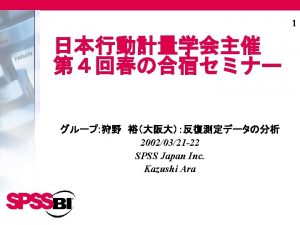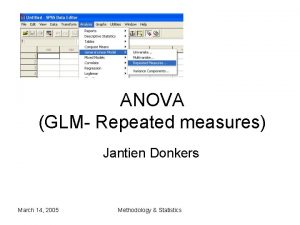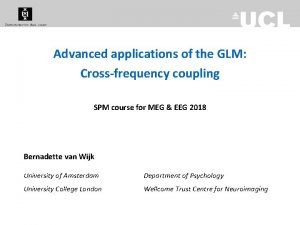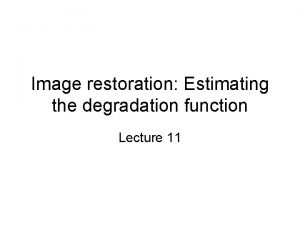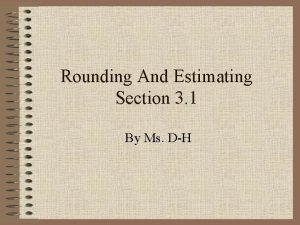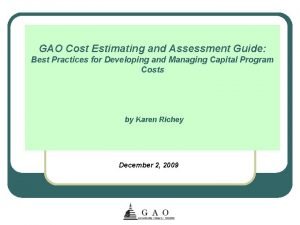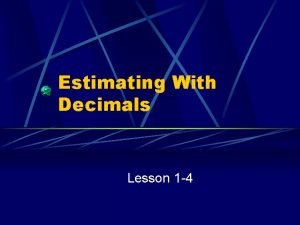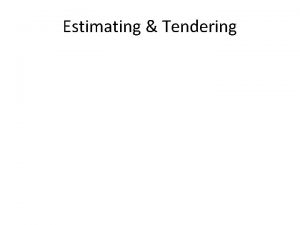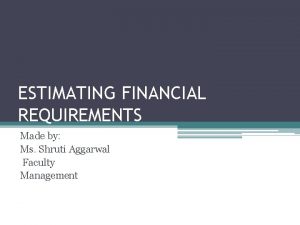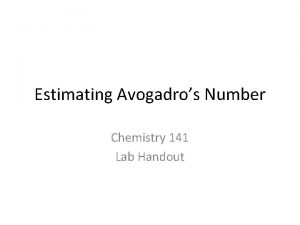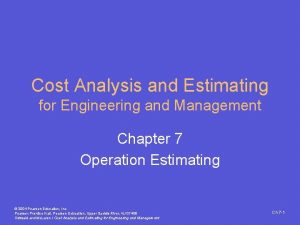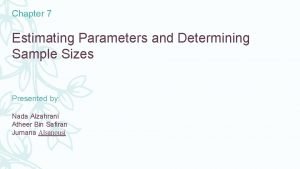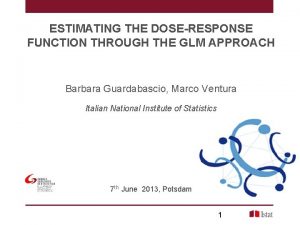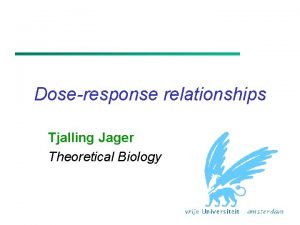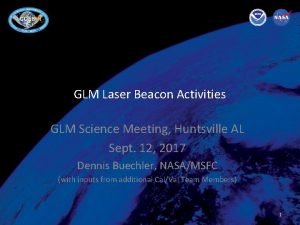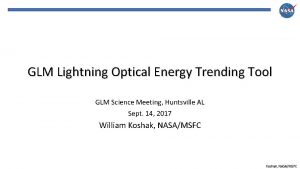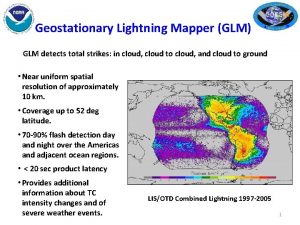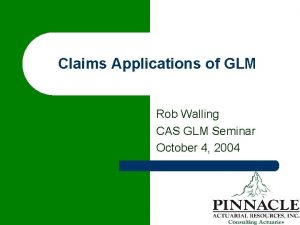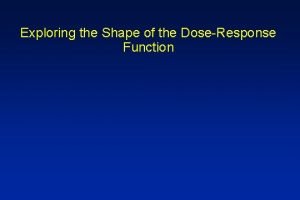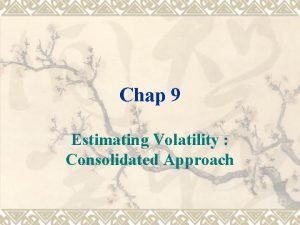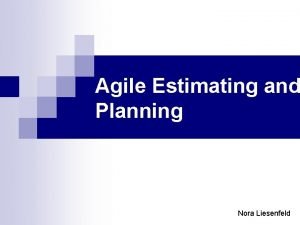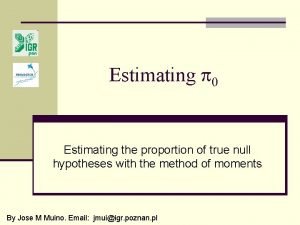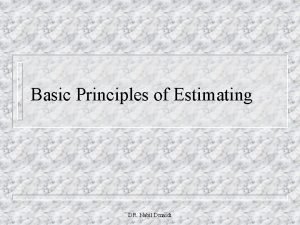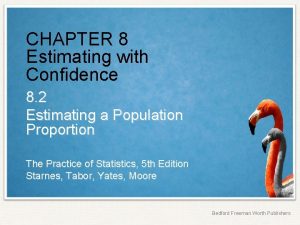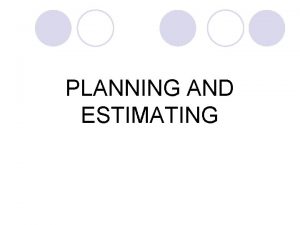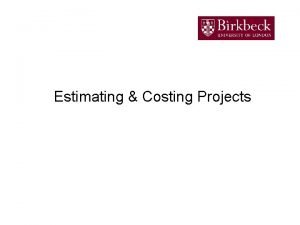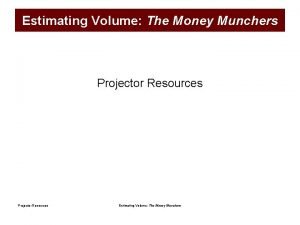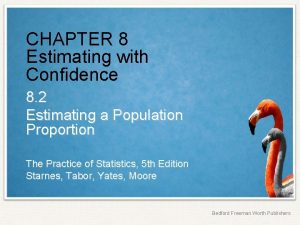ESTIMATING THE DOSERESPONSE FUNCTION THROUGH THE GLM APPROACH































- Slides: 31

ESTIMATING THE DOSE-RESPONSE FUNCTION THROUGH THE GLM APPROACH Barbara Guardabascio, Marco Ventura Italian National Institute of Statistics 7 th June 2013, Potsdam 1

Outline of the talk Ø Motivations; Ø literature references; Ø our contribution to the topic; Ø the econometrics of the dose-response; Ø how to implement the dose-response; Ø our programs; Ø applications. 2

Motivations Ø Main question: how effective are public policy programs with continuous treatment exposure? Ø Fundamental problem: treated individuals are self-selected and not randomly. Treatment is not randomly assigned Ø (possible) solution: estimating a dose-response function 3

Motivations Ø What is a dose-response function? It is a relationship between treatment and an outcome variable e. g. : birth weight, employment, bank debt, etc 4

Motivations Ø How can we estimate a dose-response function? It can be estimated by using the Generalized Propensity Score (GPS) 5

Literature references 1. Propensity Score for binary treatments: Rosenbaum and Rubin (1983), (1984) 2. for categorical treatment variables: Imbens (2000), Lechner (2001) 3. Generalized Propensity Score for continuous treatments: Hirano and Imbens, 2004; Imai and Van Dyk (2004) 6

Our contribution Ø Ad hoc programs have been provided to STATA users (Bia and Mattei, 2008), but … … these programs contemplate only Normal distribution of the treatment variable (gpscore. ado and doseresponse. ado) Ø We provide new programs to accommodate other distributions, not Normal. (gpscore 2. ado and doseresponse 2. ado) 7

The econometrics of the dose-response Ø {Yi(t)} set of potential outcomes for Ø Where [t 0, t 1] is the set of potential treatments over 8

The econometrics of the dose-response Let us suppose to have N individuals, i=1 … N Xi vector of pre-treatment covariates; Ti level of treatment delivered; Yi (Ti) outcome corresponding to the treatment Ti 9

The econometrics of the dose-response Ø We want the average dose response function Ø Hirano-Imbens define the GPS as the conditional density of the actual treatment given the covariates 10

The econometrics of the dose-response Ø Balancing property: Within strata with the same r(t, x) the probability that T=t does not depend on X 11

The econometrics of the dose-response Ø If weak unconfoundedness holds we have This means that the GPS can be used to eliminate any bias associated with differences in the covariates and … 12

The econometrics of the dose-response Ø The dose-response function can be computed as: 13

How to implement the GPS Ø The dose-respone can be implemented in 3 steps: FIRST STEP: 1. Regress Ti on Xi and take the conditional distribution of the treatment given the covariates Ti| Xi 14

How to implement the GPS Where f(. ) is a suitable transformation of T (link) D is a distribution of the exponential family β parameters to be estimated σ conditional SE of T|X 15

How to implement the GPS 1 a. Test the balancing property 16

How to implement the GPS SECOND STEP: Model the conditional expectation of E[Yi| Ti, Ri ] as a function of Ti and Ri 17

How to implement the GPS THIRD STEP: Estimate the dose-response function by averaging the estimated conditionl expectation over the GPS at each level of the treatment we are interested in 18

How to implement the GPS Ø Where is the novelty? in the FIRST STEP Ø Instead of a ML we use a GLM ü exponential distribution (family) ü combined with a link function 19

our programs LinkDistr Normal Inv. Normal Binomial Poisson Neg. Binomial Gamma Identity X X X Log X X X X X Logit X Probit X Cloglog X Power Opower X X Nbin X Loglog X Logc X 20

our programs We have written two programs: Ø doserepsonse 2. ado; estimates the dose-response function and graphs the result. It carries out step 1 – 2 – 3 of the previous slides by running other 2 programs 21

our programs Ø gpscore 2. ado: evaluates the gpscore under 6 different distributional assumptions step 1 of the previous slides Ø doseresponse_model. ado: Carries out step 2 of the previous slides 22

our programs doseresponse 2 varlist , outcome(varname) t(varname) family(string) link(string) gpscore(newvarname) predict(newvarname) sigma(newvarname) cutpoints(varname) nq_gps(#) index(string) dose_response(newvarlist) Options t_transf(transformation) normal_test(test) normal_level(#) test_varlist(varlist) test(type) flag(#) cmd(regression_cmd) reg_type_t(string) reg_type_gps(string) interaction(#) t_points(vector) npoints(#) delta(#) bootstrap(string) filename(filename) boot_reps(#) analysis(string) analysis_leve(#) graph(filename) flag_b(#) opt_nb(string) opt_b(varname) detail 23

our programs gpscore 2 varlist , t(varname) family(string) link(string) gpscore(newvarname) predict(newvarname) sigma(newvarname) cutpoints(varname) index(string) nq_gps(#) Options t_transf(transformation) normal_test(test) normal_level(#) test_varlist(varlist) test(type) flag_b(#) opt_nb(string) opt_b(varname) detail 24

Application Data set by Imbens, Rubin and Sacerdote (2001); The winners of a lottery in Massachussets: amount of the prize (treatment) Ti earnings 6 years after winning (outcome) Yi age, gender, education, # of tickets bought, working status, earnings before winning up to 6 Xi 25

Application: flogit Fractional data: flogit model. Treatment: prize/max(prize) outcome: earnings after 6 year family(binomial) link(logit) 26

Application: flogit 27

Application: count data Count data: Poisson model. Treatment: years of college+ high school outcome: earnings after 6 year family(poisson) link(log) 28

Application: count data 29

Application: gamma distribution Gamma distribution: Treatment: age outcome: earnings after 6 year family(gamma) link(log) 30

Application: gamma distribution 31
 Dhyah
Dhyah Glm mat3 constructor
Glm mat3 constructor Glm repeated measures
Glm repeated measures Glm nedir
Glm nedir Glm
Glm Glm cross
Glm cross Estimating the degradation function
Estimating the degradation function By one man sin
By one man sin Dome of furcation
Dome of furcation Tangential timber conversion
Tangential timber conversion Night of the scorpion themes
Night of the scorpion themes Datagram switching vs virtual circuit
Datagram switching vs virtual circuit Theoretical models of counseling
Theoretical models of counseling Waterfall and sprinkler strategy
Waterfall and sprinkler strategy Multiple conflict
Multiple conflict Cognitive approach vs behavioral approach
Cognitive approach vs behavioral approach Research approach definition
Research approach definition Diagram for traditional approach
Diagram for traditional approach Deep learning approach and surface learning approach
Deep learning approach and surface learning approach Types of tps system
Types of tps system Front-end rounding
Front-end rounding Mcaces mii
Mcaces mii Gao cost estimating guide
Gao cost estimating guide Rounding and estimating decimals
Rounding and estimating decimals Tendering and estimating
Tendering and estimating Estimating financial requirements
Estimating financial requirements Estimating earthwork quantities
Estimating earthwork quantities Concrete weight per cubic foot
Concrete weight per cubic foot Estimating avogadro's number lab
Estimating avogadro's number lab Electrical estimation and costing
Electrical estimation and costing Cost analysis and estimating for engineering and management
Cost analysis and estimating for engineering and management Common critical values
Common critical values
